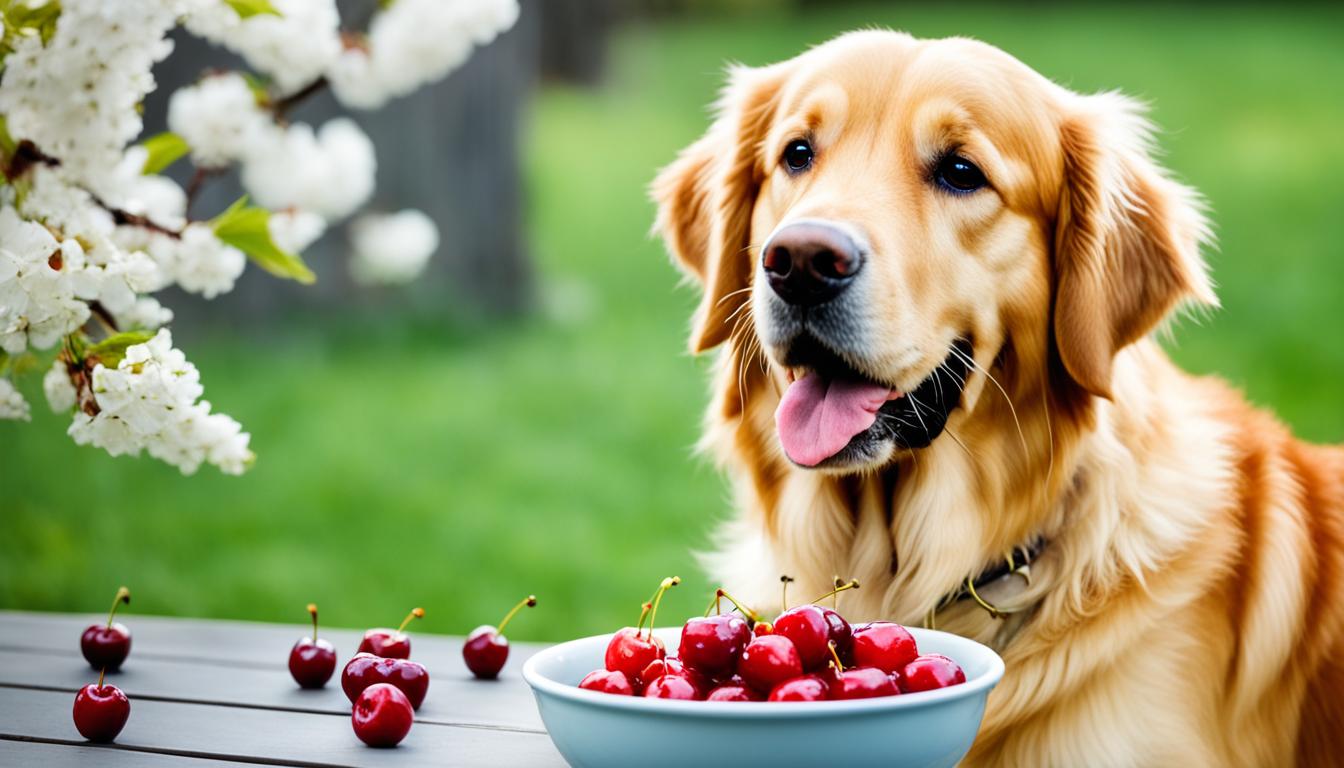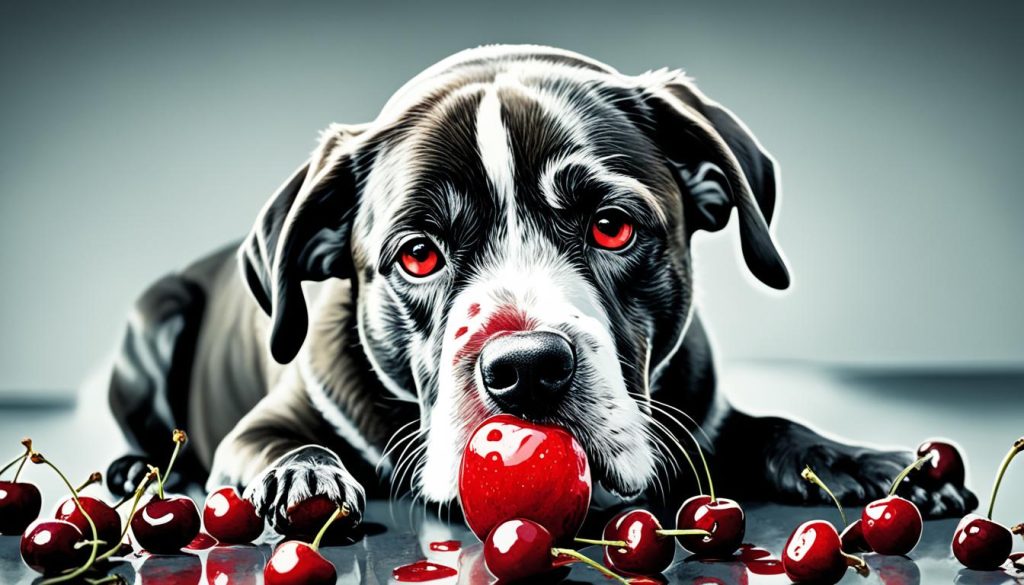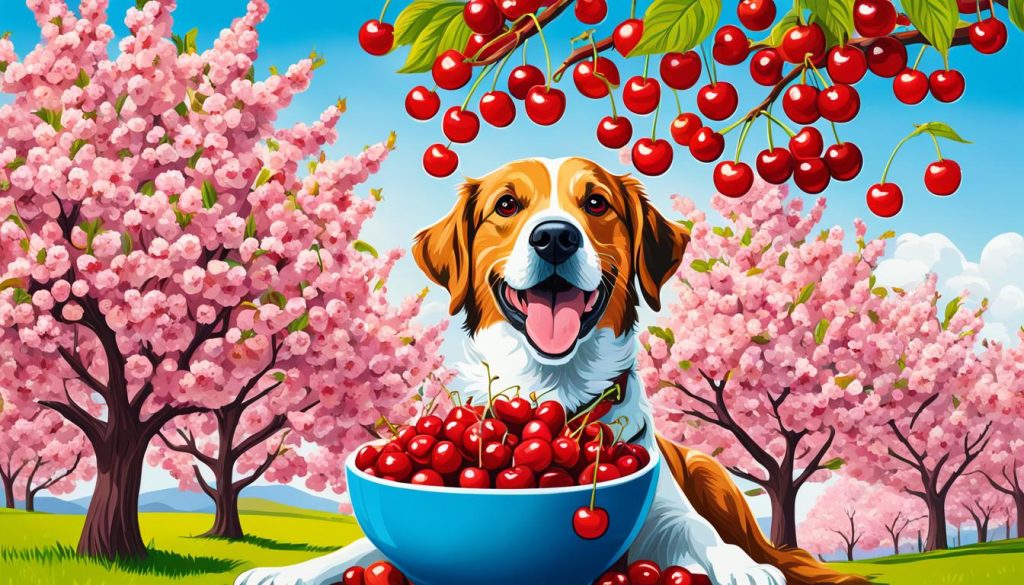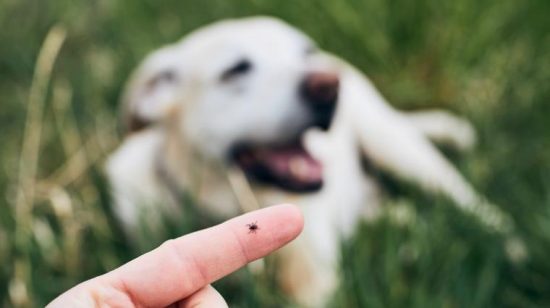Can Dogs Eat Cherries? A Guide for Pet Owners
Discover if can dogs eat cherries safely, the risks involved, and what to do if your pup indulges in this fruity treat.

Did you know that cherries, those delightful little fruits loved by many, can pose a potential danger to your canine companion? While cherries may be a tasty treat for humans, they might not be suitable for our furry friends. Before you offer a cherry to your dog, it’s important to understand the risks involved and make an informed decision to keep them safe and healthy.
Now, we will explore the topic of whether or not dogs can eat cherries. We will discuss the potential toxicity of cherry pits, stems, and leaves, and the signs of intestinal blockage that can occur if a dog ingests these components. Additionally, we will cover the nutritional aspects of cherries for dogs and provide safe fruit alternatives that can be included in their diet.
Understanding the Risks: Can Dogs Eat Cherries?
When it comes to cherries and dogs, it’s important to understand the potential risks associated with their consumption. While cherries can be a delicious and nutritious snack for humans, they can pose dangers to our four-legged friends. One of the key risks lies in the toxicity of cherry components such as pits, stems, and leaves. These parts of the cherry contain cyanide, a harmful substance that can be toxic to dogs when ingested.

Cherry pits, stems, and leaves contain cyanide, which is a highly toxic substance for dogs. When a dog ingests these parts of the cherry, it can lead to cyanide poisoning, which can have severe consequences on their health. Toxic components of cherries like cyanide can interfere with a dog’s oxygen-carrying capacity, affecting their cells, tissues, and organs. This can manifest in symptoms such as difficulty breathing, elevated heart rate, and even neurological issues.
What to Do if Your Dog Eats a Whole Cherry
If your dog has accidentally swallowed a whole cherry, it’s important to take prompt action to ensure their safety and well-being. While the consumption of cherries can pose certain risks to dogs, it’s essential to monitor for symptoms of intestinal blockage and recognize the signs of cyanide poisoning. After your dog has ingested a whole cherry, keep a close eye on their behavior and watch for any signs of intestinal blockage. These symptoms may include:
- Vomiting
- Decreased appetite
- Abdominal pain and discomfort
- Lethargy
If you notice any of these symptoms, it’s crucial to consult your veterinarian immediately. Intestinal blockage can be a serious condition that requires immediate medical attention.
Recognizing the Signs of Cyanide Poisoning
Cherry pits contain a component called amygdalin, which can release cyanide when ingested. It’s important to be aware of the signs of cyanide poisoning in dogs, which may include:
- Difficulty breathing
- Bright red gums and tongue
- Abnormal heart rate
- Seizures
If you observe any of these symptoms or suspect cyanide poisoning, contact your veterinarian or an emergency veterinary clinic right away.

Remember, if your dog has swallowed a whole cherry or if you suspect any complications, it’s always best to consult with a veterinarian. They will be able to provide appropriate guidance and determine the best course of action for your furry friend’s health.
The Nutritional Aspect: How Good Are Cherries for Dogs?
When it comes to cherries, their nutritional value for dogs is certainly worth exploring. Cherries are packed with essential vitamins and antioxidants that can provide several health benefits for your furry friend. Cherries are rich in vitamins A and C, both of which play crucial roles in supporting a dog’s immune system and promoting overall wellness. Vitamin A is essential for maintaining healthy vision and skin, while vitamin C acts as a powerful antioxidant, helping to combat free radicals and reduce inflammation.
In addition to vitamins, cherries also contain antioxidants such as anthocyanins and quercetin. These compounds have been shown to possess anti-inflammatory and anti-cancer properties, making cherries a potentially valuable addition to a dog’s diet.
The Dilemma of Natural Sugar Content in Cherries
While cherries offer several nutritional benefits, it is crucial to consider the natural sugar content they contain. Cherries are naturally sweet thanks to their fructose content, which can potentially cause issues for dogs, especially those with diabetes or weight concerns. Feeding cherries to your dog in moderation is key. Remember, dogs have different metabolic systems compared to humans, and their digestive systems may not handle sugar as effectively. Monitoring your dog’s sugar intake is crucial to avoid any negative health effects. If you decide to feed cherries to your dog, make sure to remove the pits, stems, and leaves, as they can be toxic and cause potential harm. Serving cherries as a treat or occasionally incorporating them into their diet can be a nutritious and enjoyable experience for your furry friend.

As with any alterations to your dog’s diet, it’s always important to consult with your veterinarian before introducing cherries or any new food into their routine. They will be able to provide personalized advice based on your dog’s specific needs and health condition.
Preventative Measures: Keeping Cherries Away from Dogs
When it comes to cherries and dogs, prevention is key. By taking a few simple steps, you can ensure the safety of your furry friend and prevent any potential issues associated with cherry consumption. Next, we will discuss the importance of safe storage practices for pet owners and educating your family on the dangers of cherries to pets.
Safe Storage Practices for Pet Owners
One of the most effective ways to prevent your dog from accessing cherries is to store them securely. Keep cherries out of your dog’s reach by storing them in a high cabinet or airtight container. Dogs are known for their curiosity and agility, so make sure to choose a storage location that is inaccessible to them. This will help minimize the risk of accidental cherry ingestion and potential health complications.
Additionally, it’s important to be mindful of where you discard cherry pits and stems. Dogs are notorious for rummaging through trash and may be tempted to consume discarded cherry parts. To prevent this, dispose of cherry pits and stems in a lidded trash can or a secure outdoor container that your dog cannot access.
Educating Your Family on the Dangers of Cherries to Pets
Ensuring that your entire family is educated about the dangers of cherries to pets is crucial in preventing accidental ingestion. Educate them about the potential risks associated with cherries, including the toxic components and the symptoms of intestinal blockage. Emphasize the importance of not feeding cherries to your dog and the need for vigilance when consuming cherries in the presence of pets. Furthermore, educate your family on the safe storage practices mentioned above.
Encourage open communication and reinforce the message that the well-being of your four-legged companion is everyone’s responsibility. By implementing these preventative measures, you can significantly reduce the chances of your dog consuming cherries and experiencing any associated health issues. Taking these steps will help keep your beloved pet safe and healthy.
Dealing with Accidental Cherry Ingestion in Dogs
While it’s important to keep cherries away from dogs due to their potential toxicity, accidents can still happen. If your dog accidentally ingests cherries, it’s crucial to take immediate action to minimize any potential harm.If you catch your dog eating cherries, do not panic. Start by removing any remaining cherries within your dog’s reach to prevent further consumption. Stay calm and carefully observe your dog for any signs of distress or adverse reactions.
If your dog has only ingested a small amount of cherries and doesn’t show any symptoms, inducing vomiting may be a suitable course of action. However, it’s essential to consult with your veterinarian first before inducing vomiting, as this is not recommended in all situations.
Do not attempt to induce vomiting if your dog is exhibiting any of the following conditions:
- Unconsciousness
- Difficulty breathing
- Presence of sharp objects or bones in the throat
- Seizures or convulsions
When to Seek Veterinary Assistance
It’s important to understand when it’s necessary to seek veterinary assistance for cherry ingestion. While minor cherry ingestion may not cause significant harm, certain situations warrant professional evaluation:
- If your dog has ingested a large quantity of cherries
- If your dog is exhibiting symptoms of cyanide poisoning, such as difficulty breathing, bright red gums, or collapse
- If your dog is showing signs of intestinal blockage, such as vomiting, abdominal pain, or constipation
- If your dog has a pre-existing medical condition that may be exacerbated by cherry ingestion
Identifying Non-Toxic Fruits for Your Canine
While cherries may not be suitable for your dog’s diet, there are many non-toxic fruits that can provide them with essential nutrients and a refreshing treat. It’s important to choose fruits that are safe for dogs to consume to avoid any potential health risks. Here are some non-toxic fruits that can replace cherries in your dog’s diet:
Safe Fruits That Can Replace Cherries in Your Dog’s Diet
To satisfy your dog’s cravings for a sweet and juicy snack, consider offering them these non-toxic fruits:
- Blueberries: Packed with antioxidants, blueberries are a nutritious and delicious choice for your canine friend. They can help support their immune system and promote overall well-being.
- Watermelon: A hydrating fruit, watermelon is a great option for keeping your dog cool on hot summer days. It is also low in calories and loaded with vitamins A and C.
- Bananas: Rich in potassium and dietary fiber, bananas are a safe and easily digestible fruit for dogs. They can be served as a tasty treat or added to your dog’s meals as a nutritional boost.
- Strawberries: Not only do strawberries make a refreshing snack, but they are also a good source of vitamins and antioxidants. Just make sure to remove the stem and leaves before feeding them to your dog.
- Pineapple: This tropical fruit is packed with bromelain, an enzyme that aids in digestion. Pineapple can also provide your dog with important vitamins and minerals.
The Importance of Moderation and Variety in Fruits
While these non-toxic fruits are safe for dogs to enjoy, it is essential to remember the importance of moderation and variety in their fruit consumption. Fruits should only make up a small portion of your dog’s diet, as they are higher in natural sugars. Too much fruit can lead to digestive upset or weight gain. It’s also crucial to offer a diverse range of fruits to ensure your dog receives a wide spectrum of vitamins, minerals, and antioxidants. By incorporating a variety of fruits into their diet, you can provide a balanced nutritional profile and promote their overall health and well-being. Remember, if you have any concerns about introducing new fruits into your dog’s diet or if your dog has any existing health conditions, consult with your veterinarian for personalized guidance.
Can a Dog Eat Cherries with Skin?
The skin of cherries can be tough and fibrous, making it difficult for dogs to digest. If your dog ingests cherry skins, they may experience discomfort, upset stomach, or diarrhea. In some cases, cherry skins can cause blockages in the gastrointestinal tract, requiring immediate veterinary attention. To prevent these digestive issues, it is best to remove the skin before feeding cherries to your dog.
How to Properly Prepare Cherries for Your Dog?
To ensure the safety of cherries for your dog, it is essential to take the proper preparation steps. Start by washing the cherries thoroughly to remove any dirt, pesticides, or residue. Next, carefully remove the skin by gently peeling it off or using a fruit knife to separate it from the flesh. Once the skin is removed, you can offer the cherry flesh to your furry friend as a treat or mix it with their regular food.
FAQs on Can dogs eat cherries
What are the risks associated with dogs consuming cherries?
The pits, stems, and leaves of cherries pose a danger to dogs as they contain cyanide. Ingesting these parts can lead to cyanide poisoning and intestinal blockage, which can be life-threatening.
Are cherries beneficial for dogs?
While cherries can contain vitamins and antioxidants that are beneficial for dogs’ health, the natural sugar content in cherries should be taken into consideration. It is important to feed cherries to dogs in moderation as part of a balanced diet.
How can I prevent my dog from accessing cherries?
To keep cherries away from your dog, store them in a secure location that is out of your dog’s reach. It is also crucial to educate your family about the dangers of cherries to pets to ensure they are not given to dogs accidentally.
What actions should I take if my dog eats cherries accidentally?
If your dog accidentally eats cherries, you can induce vomiting by contacting your veterinarian for instructions. It is also important to observe your dog for any symptoms of cyanide poisoning or intestinal blockage and seek veterinary assistance if necessary.
What are some non-toxic fruits that dogs can safely eat?
Some safe fruits that can replace cherries in a dog’s diet include apples, blueberries, watermelon, and strawberries. These fruits provide various vitamins and antioxidants beneficial for dogs.





